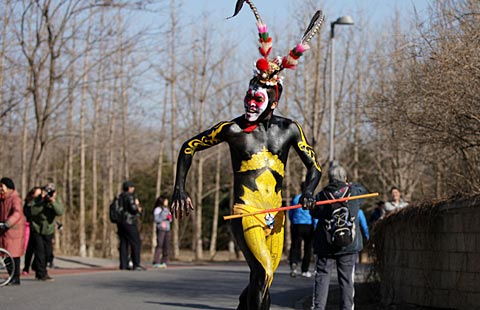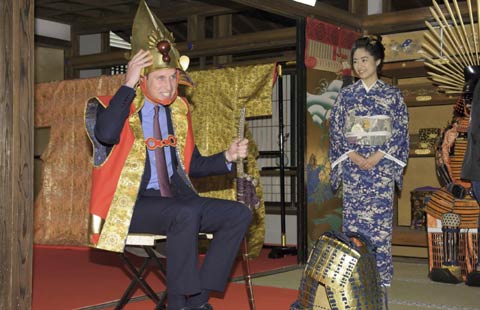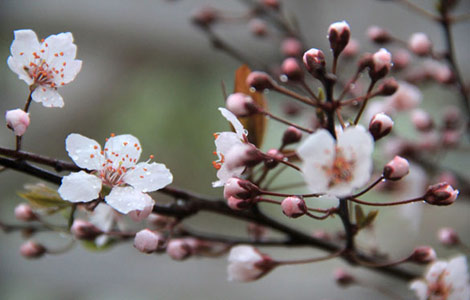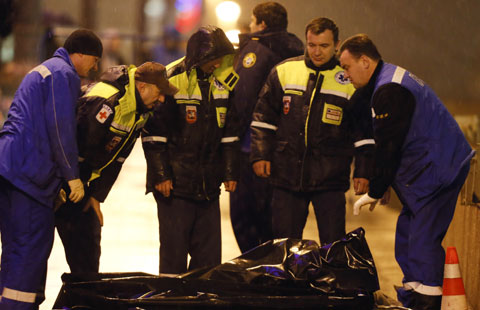Wanderlust hits Chinese
Updated: 2015-03-02 07:03
By Yang Feiyue(China Daily)
|
||||||||
More people from the mainland are traveling abroad with their families during the Lunar New Year break. Yang Feiyue reports.
A strong renmenbi and relaxed visa policies in some countries encouraged more Chinese to spend their Spring Festival holiday abroad this year, according to a report from the China National Tourism Administration.
A total of 5.18 million Chinese (not including people from Hong Kong and Macao) left the country on vacation from Feb 18 to 24, up approximately 10 percent compared with the figure for the same period last year, the report said.
Japan, South Korea, Thailand and Southeast Asian islands remained popular destinations, thanks to their proximity to China, while long-haul trips to Australia and the United States also saw a significant growth in the number of Chinese tourists during the festival, the report added.
"Spring Festival is one of the two weeklong holidays for most Chinese, who are more likely to use the opportunity to take their families abroad for an exotic experience," says Jiang Yiyi, director of the Beijing-based think tank International Tourism Development Institute. The other weeklong holiday surrounds National Day in October.
An increasing number of countries have rolled out the red carpet for Chinese tourists. The Sydney Opera House used the color red for decorations on the eve of Spring Festival, so that Chinese tourists could feel elements of the celebration abroad, Jiang adds.
Some countries staged special programs to cater to the needs of Chinese tourists, according to the report.
Spain has developed a group of Chinese-friendly hotels that feature Chinese menus, Chinese TV channels and other services, while some US hotels briefed their staff on how to attend to Chinese guests and arranged special celebrations for the Lunar New Year.
More Chinese also chose to go abroad for the holiday because the domestic tourism market is "bursting at the seams", Jiang points out.
For those who stayed in the country, there were more than enough tourism attractions to keep them happily occupied.
The report points out that most domestic travelers sought out hot springs and ice and snow entertainment. People who wanted to escape the snow and the cold headed south to where they could enjoy warmer weather.
Various hot springs across Jilin province were packed with tourists, and likewise, local ski resorts.
Other hot spring scenic spots in Jiangsu, Guizhou and Hunan provinces also drew large numbers of tourists. Hotels in these spots were fully booked during the holiday.
The number of tourists who flew to Hainan province to escape the cold increased by 4.44 percent year-on-year and those who drove to the island grew by 5.85 percent during the holiday. Local high-end hotels saw occupancy rates of about 80 percent.
"China has wide regional diversity. Many Chinese have not experienced snow where they live and want to explore tourism spots that boast lots of snow," Jiang says.
She says Club Med set up a facility near Yabuli ski resort in Heilongjiang province, and the Wanda Group established a hotel cluster near Changbai Mountain in Jilin province, offering a comfortable and leisurely experience for tourists to ski and go sightseeing.
Other major areas in China also witnessed significant growth in the tourism market over the holiday.
Beijing received 9.01 million tourists during the festival, including 1.43 million from other parts of China and overseas, up 7.1 percent year-on-year. Tourism revenues amounted to 4.8 billion yuan ($762 million), up 9.1 percent, according to local government agency Beijing Tourism Development Commission.
Temple fairs remained the biggest attraction. The Ditan temple fair, the biggest of its kind in Beijing, attracted about 978,000 visitors, followed by the Longtan and the Old Summer Palace fairs.
Jiangsu, Shandong and Liaoning provinces and Shanghai all witnessed growth in both the number of tourists and tourism revenue, according to the report.
The Guangxi Zhuang autonomous region staged more than 100 festive celebrations, and Guizhou province organized 90 cultural activities to bring in tourists.
Yan'an, Tongchuan and Xi'an in Shaanxi province stood out as new hot tourism destinations after President Xi Jinping's visits to these cities on the eve of Spring Festival, the report said.
Despite the large numbers of people up and about, public order was maintained. The national tourism administration received 93 complaints, down 50.3 percent from last year.
Major travel agencies, hotels and shopping facilities have strengthened their business operations, leading to improved levels of customer satisfaction.
Contact the writer at yangfeiyue@chinadaily.com.cn
(China Daily 03/02/2015 page24)
- Japan has to reflect on history: former PM
- Prince William played with kids on Japan tsunami trip
- Homeland Security funding drama darkens US fiscal outlook
- African wildlife agency lauds China's ban on ivory imports
- China ends UN council presidency, eyeing 70th birthday
- Russian opposition leader Nemtsov shot dead in Moscow

 Monkey king, angel and superwoman at Beijing's 'naked run' race
Monkey king, angel and superwoman at Beijing's 'naked run' race
 Red-crowned cranes in Yancheng
Red-crowned cranes in Yancheng
 Prince William evokes Diana memories on Japan tsunami trip
Prince William evokes Diana memories on Japan tsunami trip
 Best times to view spring flowers in Beijing
Best times to view spring flowers in Beijing
 Dragon boat race to celebrate Chinese New Year in Sydney
Dragon boat race to celebrate Chinese New Year in Sydney
 South Pole setting for wedding photos, penguins included
South Pole setting for wedding photos, penguins included
 Milan Fashion Week - Autumn/Winter 2015-16
Milan Fashion Week - Autumn/Winter 2015-16
 Russian opposition leader Nemtsov shot dead in Moscow
Russian opposition leader Nemtsov shot dead in Moscow
Most Viewed
Editor's Picks

|

|

|

|

|

|
Today's Top News
Homeland Security funding drama darkens US fiscal outlook
17th Apple retail store in Chinese mainland opens in Shenyang
PBOC cuts rates to ease business financing
Former celebrity TV anchor on crusade against pollution
China ends UN council presidency
Ling Jihua removed from CPPCC leadership list
Tech firms cut from approval list
Yuan on move, but not to top
US Weekly

|

|







